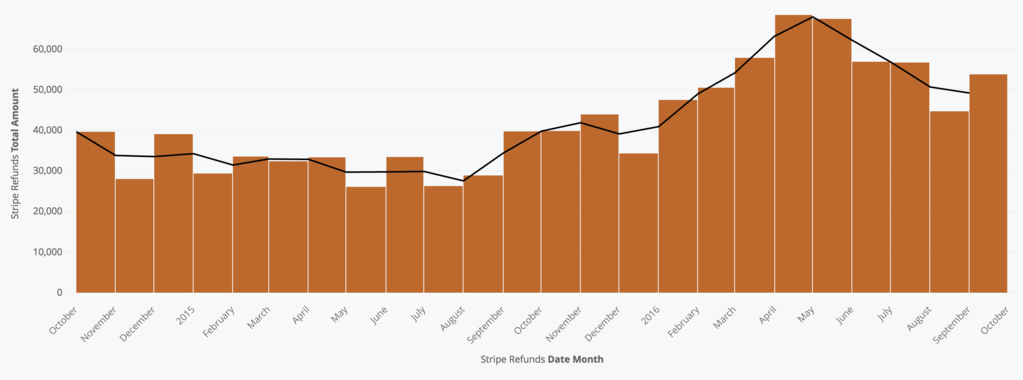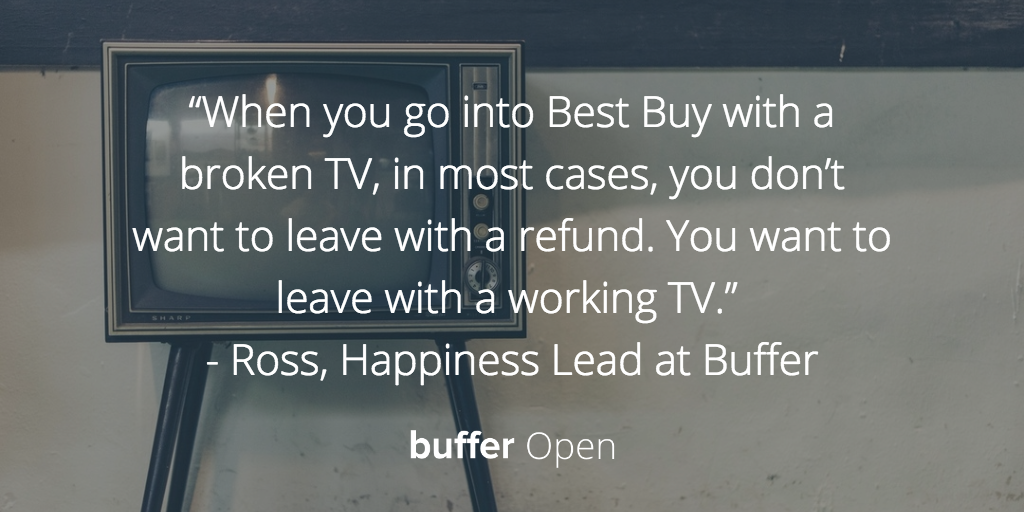
What Happened When We Cut Back on Refunds: A Customer Service Experiment
Chief of Staff @ Buffer
In Buffer’s history we’ve tried many different experiments that have soared – or flopped.
Some with our culture. Some with our management structure (or lack thereof!). Some with launching products.
If a belief or philosophy hasn’t been examined recently, we like to take a closer look and perhaps try something new. We feel that one of our biggest responsibilities as a transparent company is to share the story of these experiments – what went well, and what went wrong.
On our customer service team, for example, we’ve had a years-long philosophy of proactively offering refunds whenever we felt that a customer didn’t have a great experience. This generous approach has served us well through the years, but the details and execution hadn’t been questioned or examined in a while.
So, over the past few months, we’ve dug in, and in one specific case, changed our approach to refunds. Here’s the full story of what we tried, what happened as a result, and how we’re moving forward.
The $67,000 mystery
As a result of our cash flow crisis in June of 2016, we started to take a closer look at all the numbers across the whole company.
We discovered refunds were at an all-time high of nearly $67,000 per month in May and June—almost double our past averages.

What was going on? In order to get to the bottom of all of this, we put a pause on giving most refunds and tried to learn from each one.
Meanwhile, our Happiness team lead, Asa, took a sample of about 20% of our refunds for three weeks to find out what might explain the drastic increase.
Why we give refunds
There are a few typical reasons we offer refunds:
- A few folks every month get in touch because they didn’t realize they were paying for Buffer. (They thought they had canceled, or someone left a company and the rest didn’t know about Buffer, or a variety of other reasons.)
- As with any business or purchase, sometimes people change their minds about a service and want their money back.
- Lastly, as mentioned, we tried to proactively offer refunds whenever we felt that a customer didn’t have a great experience.
In addition to these typical reasons, our research we found another element contributing to the especially high level of refunds being given:
Some trials for our Buffer for Business plan were resulting in accidental upgrades—around 100–150 a month of 3,000 to 9,000 trials ending.
Either we were causing the customer some confusion during the upgrade process, or the account was automatically upgraded at the end of the trial. Not a great experience either way! We were giving a lot of refunds as a result of this.
After the audit, what went right: We solved the mystery and learned a lot
Many of the learnings from this refunds exploration were very positive.
First, we were able to share both quantitative and qualitative feedback with the Growth and Product teams about the impact of automatic trial upgrades.
As a result, they dug into their data, had some great philosophical conversations about the best experience and what “doing the right thing” looks like in this context, and then made some changes to the trial upgrade flow.
We also uncovered some other great lessons!
We learned that our policy of proactively refunding money when the customer hadn’t asked often had little impact on the conversation. (“Oh, cool, yeah, thanks, can you still fix the issue though? The refund doesn’t really change the fact that this isn’t a great experience.”)
Of course, in some cases, it helped communicate our intentions and showed good will. However, at worst, this refund was sometimes upsetting to customers. (“If you think a $20 refund makes up for the amount of time I’ve lost on this, that’s a slap in the face.”)
One of our Happiness Leads, Ross, said it best: “When you go into Best Buy with a broken TV, in most cases, you don’t want to leave with a refund. You want to leave with a working TV.”

As a result, we have now taken the emphasis off of refunding as a band-aid, and instead work even harder to reach customer satisfaction with the value of the product and the price paid for it.
Third, we uncovered a challenge with refunding very old payments. In certain cases, we were issuing refunds, but they weren’t getting through to the customer. This was very helpful to learn so that we never promise a refund that the customer doesn’t receive!
Lastly, we arrived at some norms about how far back to give refunds when the customer hadn’t been using the account.
One thing that didn’t feel quite right: Stopping some refunds
However, there was one thing that we want to call attention that didn’t feel quite right: The decision to stop offering refunds for payments that were more than two months old.
It was, to be fully honest, a bit of a hasty (or lazy) solution to determine how to standardize refunds more than we had in the past.
Asking our heroes to make judgement calls on every refund case has two major costs: it means that we risk giving different answers to customers depending on the moment, and it’s emotionally taxing on the Heroes.
We believed that creating a “policy” would decrease those costs and be a relief to the team. However, looking back, we now realize that not granting any refunds over two months old was short-sighted, and far too simple.
It also put us in the position of occasionally saying “no” to folks who asked for a refund, even if they had not used the account, or completed the subscription. This was new for us, and it didn’t feel great at all.
Some common situations in which this new policy became especially relevant were the cases of customers who had paid for an annual plan. If a customer bought an annual plan three months ago, but finds that Buffer is not the right solution after all and asks for a pro-rated refund now, what should we do?
Here’s a note that Åsa and I wrote to the Heroes after realizing the very uncomfortable position that we put our Happiness team in.
As a result of this time, each of you have had to quiet your conscience, and say no to refunding a customer who paid for an annual plan and wanted a pro-rated refund for the unused time. This was despite our deep gratitude for our customers, our value of “do the right thing,” and the language on the upgrade page of, “cancel and get a refund anytime.”
There are a few things that we’d like to share.
First, gratitude: for your strength, trust, and willingness to try experiments, even when it is new and uncomfortable.
Thank you for coming on this refunds journey with us, for temporarily suspending your hesitations and giving this a try, and for trusting so deeply in us, and this process (where we often experiment, sometimes get things wrong, but always try to find our way home!).
Now, an apology: We want to tell each of you how sorry we are for asking you to do something that didn’t feel right to you. We are so grateful for your steadfastness, your loyalty to Buffer, and to those of you who gently voiced your hesitations here and invited us to rethink it.
We will try to learn from this, remember this experience next time, and try to always “choose what’s best for customers and the company in the long-term, and strive to provide the best solution, even if that means foregoing profit.”
What’s next?
We’re so glad that we have the space to challenge assumptions, and collectively learn. Many of the lessons we uncovered feel great to have learned.
From here on out, we have, what we feel, is a much more balanced policy for refunds. We have a bit more detailed guidelines for our Heroes on how to approach old charges, as well as how to pro-rate annual plans and refund unused plan times.
We hope this represents our values much more closely, and we’re going to keep a close eye on things to ensure we’re good stewards of our customers’ money and are able to sustain our business in a healthy and generous way.
Over to you
Have you ever created or been part of a policy that didn’t feel quite right? Were there ways you were able to correct it and find a better solution? We’d love to hear your thoughts in the comments below!
Try Buffer for free
140,000+ small businesses like yours use Buffer to build their brand on social media every month
Get started nowRelated Articles

In this article, the Buffer Content team shares exactly how and where we use AI in our work.

With so many years of being remote, we’ve experimented with communication a lot. One conversation that often comes up for remote companies is asynchronous (async) communication. Async just means that a discussion happens when it is convenient for participants. For example, if I record a Loom video for a teammate in another time zone, they can watch it when they’re online — this is async communication at its best. Some remote companies are async first. A few are even fully async with no live ca

Like many others, I read and reply to hundreds of emails every week and I have for years. And as with anything — some emails are so much better than others. Some emails truly stand out because the person took time to research, or they shared their request quickly. There are a lot of things that can take an email from good to great, and in this post, we’re going to get into them. What’s in this post: * The best tools for email * What to say instead of “Let me know if you have any questions” a